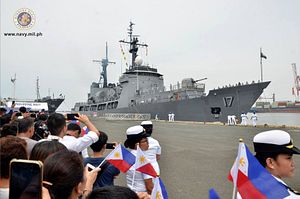On August 27, Philippine Defense Secretary Delfin Lorenzana suggested that the Philippines could step up its presence at the next iteration of the Rim of the Pacific (RIMPAC) exercises, the world’s largest international maritime exercise, which occurs biennially and just concluded earlier this month. Though the next iteration of RIMPAC does not occur till 2020, Lorenzana’s comments nonetheless deserve attention in terms of how Manila is thinking about such engagements in the context of its own security at home and abroad.
As I noted before in these pages, one of the important features regarding this year’s iteration of RIMPAC, which was held from June 27 to August 2, was that, beyond Vietnam’s new inclusion, it also witnessed the highest level of participation by Southeast Asian states to date (See: “Why Vietnam’s First RIMPAC Participation Matters”). Seven of 10 Southeast Asian countries participated in RIMPAC this year – Brunei, Indonesia, Malaysia, the Philippines, Singapore, Thailand, and Vietnam – and four of the countries that had previously participated in some capacity sent ships to RIMPAC when they had not done so before.
One of these countries is the Philippines. At RIMPAC 2018 this year, the Philippine contingent consisted of the strategic sealift vessel BRP Davao Del Sur (LD-602), frigate BRP Andres Bonifacio (FF-17), an AgustaWestland AW-109 naval helicopter, and around 700 sailors and marines.
Philippine officials have been noting the importance of exercises like RIMPAC for the Philippine military. In remarks welcoming the arrival of the Philippine contingent back from RIMPAC at Pier 13, South Harbor Manila on August 27, Lorenzana said the participation of a Philippine naval contingent marked an “important milestone” not only for the Navy, but for the defense department as a whole.
But perhaps more interestingly, Lorenzana also then went on to suggest that if the Philippines does choose to participate in this way at the next iteration of RIMPAC, scheduled for 2020, it may also step up its presence at the exercise.
While he did not offer much in the way of specifics, he said Manila could send more ships than this year – perhaps three vessels rather than two. While that may seem like only a small difference, it is significant given the limited naval capabilities that Manila possesses in spite of its continued investments in military modernization under Duterte’s watch.
Lorenzana also suggested that beyond the Navy, the Philippines could also send some Army Special Forces and Air Force Special Operations Wing personnel as well. That is not altogether surprising given the breadth of operations at RIMPAC as well as Lorenzana’s own emphasis on the involvement of the Philippine military in general, rather than just the navy. Nonetheless, it deserves mention in the context of the Philippines’ own ongoing efforts at boosting integration between these various services in domestic as well as international engagements.
Of course, while Lorenzana’s comments may be noteworthy, it remains to be seen whether they will actually be followed through on. The next iteration of RIMPAC is still far away, and given Manila’s limited capabilities, other scheduled engagements or even unforeseen developments or crises could affect its actual level of participation. As planning begins to take shape for the next RIMPAC and we get closer to the actual exercise, the general outlines will become clearer.

































